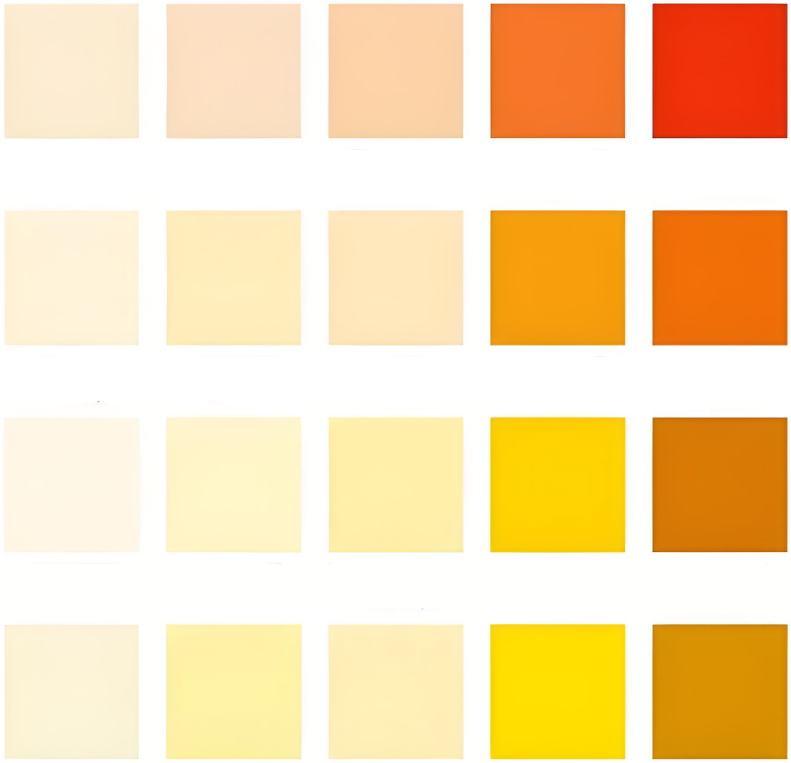The colors and components of exterior latex paint are crucial for both aesthetics and performance. Colors, ranging from whites and beiges to vibrant blues and greens, must be durable against UV rays, water, and temperature changes to maintain their vibrancy over time. The paint’s composition includes emulsions like acrylic or styrene-acrylate for film formation, pigments such as titanium dioxide for color, fillers like heavy calcium carbonate to enhance properties, and additives to improve application and longevity. Water serves as the solvent, evaporating during drying to form a cohesive film. These elements together ensure exterior latex paint offers long-lasting protection and decorative appeal for buildings.

I. The Colors of Exterior Latex Paint
1. Diversity of Colors
Exterior latex paint offers an extensive range of colors, covering almost all hues in the visible spectrum. The diversity of colors mainly originates from the types and proportions of pigments. Through color-matching systems, the following common color series can be achieved:
- White Series: White is one of the most commonly used colors, known for its simplicity and brightness. It reflects most sunlight, reducing heat absorption on building surfaces and is suitable for various architectural styles.
- Beige Series: Beige is a soft neutral color that gives a warm and comfortable feeling. It is often used for modern and European-style building exteriors.
- Gray Series: Gray is characterized by its stability and grandeur. The range from light to dark gray can meet different design requirements and enhance the sense of hierarchy when combined with other colors.
- Blue Series: Blue gives a fresh and tranquil feeling and is often used for coastal buildings or modern architectural styles. The variations in shades of blue can create different atmospheres.
- Green Series: Green is in harmony with the natural environment, giving a fresh and eco-friendly feeling. It is suitable for ecological buildings or those integrated with natural landscapes.
- Yellow Series: Yellow is bright and lively, with strong visual impact. It is often used for Mediterranean-style buildings or occasions where architectural features need to be highlighted.
- Red Series: Red is bright and passionate, with strong decorative properties. It is often used for traditional Chinese architecture or occasions where architectural style needs to be emphasized.
2. Durability of Colors
The colors of exterior latex paint need to have good durability to withstand environmental erosion. Durability is mainly reflected in the following aspects:
- UV Stability: Ultraviolet (UV) light is one of the main causes of color fading. High-quality exterior latex paint contains UV absorbers and light stabilizers that effectively absorb and reflect UV rays, thereby extending the lifespan of the colors.
- Water Resistance: Exposed to the natural environment for a long time, exterior walls are subject to rainwater washout. The colors of latex paint need to have good water resistance to prevent pigments from dissolving or fading due to moisture penetration.
- Temperature Variance Resistance: The surface temperature of exterior walls changes due to seasonal and diurnal temperature differences. The colors of latex paint need to remain stable under different temperatures to prevent color changes or paint film cracking due to thermal expansion and contraction.
- Pollution Resistance: Exterior walls are prone to contamination from dust, grease, and other pollutants. The colors of latex paint need to have certain pollution resistance. By adding hydrophobic and oleophobic additives, the adhesion of pollutants can be reduced, maintaining the brightness of the colors.
3. Color Coordination
The color selection of exterior latex paint not only needs to consider the individual color effect but also needs to consider the combination with other building materials. The following are some common coordination methods:
- Coordination with Stone: The colors of stone are usually natural, such as the white of marble and the gray of granite. Exterior latex paint can choose colors similar to or complementary to stone to enhance overall coordination.
- Coordination with Tiles: Tiles come in a wide variety of colors and textures. Latex paint can choose colors that echo the color of tiles or use contrasting colors to highlight the architectural hierarchy.
- Coordination with Glass: Glass is often used for modern building facades or windows. Latex paint can choose colors that coordinate with the color of glass, such as light colors or transparent colors, to highlight the transparency of glass.
- Coordination with Metal Materials: Metal materials such as aluminum alloy and stainless steel usually have a metallic luster. Latex paint can choose colors that coordinate with the color of metal, such as silver or gray, to enhance the modern feel of the building.
II. Conventional Components of Exterior Latex Paint
1. Emulsion
Emulsion is the core component of exterior latex paint and the main substance for film formation. It determines the basic properties of the paint film, such as adhesion, flexibility, and durability. Common types of emulsions include:
- Acrylic Emulsion: Acrylic emulsion is the most commonly used type of emulsion in exterior latex paint. It has good durability, water resistance, and color retention, and is suitable for various climatic conditions. The molecular structure of acrylic emulsion allows it to form a uniform paint film with pigments and fillers.
- Styrene-Acrylate Emulsion: Styrene-acrylate emulsion is a copolymer of styrene and acrylate. It combines the hardness of styrene with the flexibility of acrylate, offering high gloss and wear resistance. Styrene-acrylate emulsion is suitable for exterior decoration with high gloss requirements.
- Vinyl Acetate Emulsion: Vinyl acetate emulsion has good flexibility and adhesion, suitable for porous substrates. It can still form a good film at low temperatures, but its durability is relatively weak and is often mixed with other emulsions to improve performance.
2. Pigments
Pigments are the key components that give latex paint its color. Their selection and usage directly affect the color effect of the paint. Common pigments include:
- Titanium Dioxide: Titanium dioxide is a white pigment with high hiding power and high reflectivity. It is the most commonly used white pigment in exterior latex paint, effectively reflecting sunlight and reducing the surface temperature of buildings. Titanium dioxide is chemically stable and does not fade easily.
- Iron Oxide Pigments: Iron oxide pigments are inorganic pigments with good durability and chemical resistance. Common iron oxide pigments include iron oxide red, iron oxide yellow, and iron oxide black. They have bright and stable colors, suitable for color matching.
- Phthalocyanine Pigments: Phthalocyanine pigments are organic pigments with bright colors and good durability. Common phthalocyanine pigments include phthalocyanine blue and phthalocyanine green. They have high color saturation and are suitable for exterior decoration requiring bright colors.
- Carbon Black: Carbon black is a black pigment with good dispersibility and hiding power. It is used for mixing black and dark-colored latex paint, providing a uniform black effect.
3. Fillers
Fillers are mainly used to increase the volume of latex paint, reduce costs, and improve the physical properties of the paint film. Common fillers include:
- Heavy Calcium Carbonate: Heavy calcium carbonate is a commonly used filler, known for its low cost, high whiteness, and good filling properties. It can improve the hardness and hiding power of the paint film, but excessive use may affect the flexibility of the film.
- Talc: Talc is a natural mineral filler with good lubricity and dispersibility. It can improve the smoothness and application performance of the paint film, while also enhancing the water and weather resistance of the film.
- Kaolin: Kaolin is a white mineral filler with good hiding power and filling properties. It can improve the whiteness and fineness of the paint film, suitable for white or light-colored latex paint.
- Wollastonite: Wollastonite is a fibrous mineral filler with good mechanical properties and weather resistance. It can improve the hardness and wear resistance of the paint film, while also enhancing the crack resistance of the film.
4. Additives
Additives are components added in small amounts but play an important functional role in latex paint, used to improve the application performance and paint film properties of latex paint. Common additives include:
- Dispersants: Dispersants can evenly disperse pigments and fillers in the emulsion, preventing pigment agglomeration. They help improve the stability and application performance of latex paint.
- Flow Agents: Flow agents can improve the leveling of the paint film, preventing brush marks, orange peel, and bubble formation. They make the paint film surface smoother and improve the decorative effect.
- Thickeners: Thickeners can adjust the viscosity of latex paint, making it more suitable for application. They prevent the paint from flowing during application, improving application efficiency.
- Antifreeze Agents: Antifreeze agents can lower the freezing point of latex paint, preventing it from freezing at low temperatures. They are usually used for winter construction or storage conditions.
- Preservatives: Preservatives can prevent the growth of bacteria and mold in latex paint during storage, extending the shelf life of the paint.
- UV Absorbers: UV absorbers can absorb UV light, preventing pigment fading and paint film aging. They improve the durability of latex paint and extend its service life.
- Defoamers: Defoamers can prevent bubble formation during the stirring and application of latex paint. They make the paint film more uniform and improve application quality.
5. Water
Water is the solvent of exterior latex paint, used to adjust the viscosity and application performance of the paint. During application, water gradually evaporates, forming a uniform paint film from the emulsion, pigments, and fillers. The amount of water needs to be adjusted according to the application environment and paint formula. Excessive water can affect the drying speed and adhesion of the paint film, while insufficient water can make the latex paint too viscous for application.
